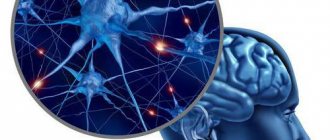Multiple sclerosis is a neurological disease characterized by a progressive course.
With this pathology, multiple lesions are observed in the central nervous system, and single lesions in the ANS. In neurological practice, this disease can also be called “multiple sclerosis”, “plaque sclerosis”, “spotted sclerosis”, etc. However, this does not change the essence: all these terms imply the same disease.
The disease is characterized by an undulating chronic course. It is diagnosed more often in women than in men, although a third of cases of its development are recorded in the stronger sex. The pathology usually manifests itself at a young age - from 20 to 45 years, and people most susceptible to it are those whose main area of activity involves mental stress.
In addition, the age limits for the incidence of multiple sclerosis are now being actively revised. In medicine, there are cases of diagnosing this pathology in children 10–15 years old. In addition, patients over 50 years of age were also included in the risk group.
What it is?
Multiple sclerosis is a chronic progressive autoimmune disease of the nervous system (a type of sclerosis). When examining the brain and spinal cord, pathological foci are detected that destroy nerve fiber cells - multiple sclerosis plaques. The classification of the disease is shown in the article.
Attention! Pathological foci are initially small in size, but over time they can increase and unite into large formations.
What can I do to avoid getting sick?
A balanced diet, yoga and quality rest will help not only relieve symptoms, but also possibly prevent risks. You should also relieve yourself of stress, reduce mental and emotional stress and quit smoking. Of course, it is not known for sure whether these measures can be used as a preventive measure, but during illness it definitely helps relieve symptoms.
In any case, people living with multiple sclerosis do not need to despair. There are organizations in our country that help people find good jobs. The approach is provided in the “Unlimited Possibilities” project, which was initiated by public organizations of disabled people “Moscow Society of Multiple Sclerosis” and “Perspective”, recruiting companies HeadHunter, Hays, as well as an international pharmaceutical company. These organizations help people with disabilities adapt to Russian society.
Causes
The basis for the development of the disease is viral infections.
The trigger can be measles, mumps, rubella or herpes, and nerve fiber cells (myelin) begin their destruction. At this point, a foreign protein is formed - a prion. Lymphocytes, as a result of the formation of foreign compounds, begin to produce antibodies. As a result, the fight occurs not with the virus, but with the cells of one’s own body. Find out more about the causes of the disease here. The immune system malfunctions, leading to an autoimmune reaction. Pathological foci form in the brain and spinal cord, which destroy myelin . They are not located in one place, but are scattered and may have different ages of formation.
What causes this disease? Factors that may influence the progression of the disease:
- Adolescence.
- Mental illness, overreaction to events in life.
- Infections of viral or microbial origin.
- Disturbances in the functioning of blood vessels.
- Hereditary predisposition.
- Radiation damage.
Diagnostics
Attention! There are no highly specific diagnostic tests to determine sclerosis.
This diagnosis in medical practice is called a “diagnosis of exclusion,” that is, its final statement is made only when all possible similar pathologies are excluded. Therefore, we have to pay special attention to the symptoms of multiple sclerosis in women.
When making a clinical diagnosis, doctors rely on:
- General blood analysis . It can help exclude inflammatory and infectious diseases that have similar clinical symptoms.
- Spinal cord puncture (in the lumbar spine). During this study in young women, the doctor removes some cerebrospinal fluid from the spinal canal for further examination under a microscope. You can see under a magnifying glass an increase in the level of leukocytes and human immunoglobulin.
- Magnetic resonance imaging . MRI can identify lesions that indicate demyelination of the central and peripheral nerve plexuses. Such lesions may be the result of other diseases, for example, systemic lupus erythematosus or Lymeborreliosis. Demyelination is not a 100% criterion for the presence of multiple sclerosis in a person.
- Electroencephalogram . This method is based on measuring the electrical signal sent by a woman’s brain as a response to irritation. This method is also called “evoked potential analysis.” Electrical impulses are applied to the upper and lower extremities and changes in the brain are measured using an electroencephalograph.
Signs of multiple sclerosis in young people
Symptoms of the disease in adolescents can be a single manifestation or in aggregate. Multiple sclerosis occurs with periods of exacerbations and quiescence .
The disease can worsen for many reasons:
- past infectious diseases;
- viruses;
- injuries;
- stressful situations;
- violation of diet, etc.
Remission can last a long time, even up to several decades, during which time a person feels absolutely healthy.
Most often, the symptoms characteristic of multiple sclerosis are the same for all ages, but some differences may be observed in adolescence and childhood. It is worth noting that diagnosing the disease at a young age is extremely difficult , since it is quite rare.
In adolescents, after sleep the following may appear:
- goosebumps before the eyes;
- muscle cramps develop;
- a depressive state that gives way to causeless euphoria;
- decreased hearing acuity;
- disruption of internal organs;
- paresis and paralysis of the limbs.
With multiple sclerosis, both young and adult, there are three main signs of the disease:
- Nystagmus, when the eyes begin to move involuntarily.
- Scanned or slow speech pronunciation.
- Intentional tremors.
Important! The onset of the disease in adolescents is accompanied by short-term visual disturbances or cerebellar signs.
Children under 6 years of age have the same symptoms as older children:
Dizziness appears, speech slows down, diplomacy is observed, and hearing acuity decreases.
- Trigeminal neuralgia is observed. This is manifested by deterioration of vision in one or both eyes, and stars appear in front of the eyes.
- Paralysis is replaced by a normal state, the functioning of internal organs may be disrupted due to the absence of the abdominal reflex.
- Trembling of the limbs, rapid fatigue when walking.
- Urinary incontinence or, conversely, difficulty urinating.
- Brain damage manifests itself as vomiting, convulsions, or coma. This is especially evident in very young children and develops rapidly.
Classification
Multiple sclerosis has its own classification, according to which it happens:
- Primary progressive. This form of the disease is characterized by a constant, steadily progressive deterioration of the patient's condition. The symptoms of the disease are mild and are accompanied mainly by disturbances in gait, vision, speech, urination, and bowel movements.
- Relapsing-remitting. Usually diagnosed in people 20 years of age. The attacks are periodic and are accompanied by pain in the eyes, lower extremities, dizziness, imbalance, and coordination of movements. This type of multiple sclerosis is also characterized by depression and impaired mental function.
- Secondary progressive. This phase of the disease occurs after the relapsing-remitting phase, which can last for years. This type of multiple sclerosis is characterized by the manifestation of ailments without alternating relapses and remissions. Patients experience severe weakness, unsteady gait, and loss of coordination. Patients complain of thickening and “hardening” of the leg muscles, digestive disorders, worsening depression, and problems with thinking.
- Progressive-recurrent. This type of multiple sclerosis is much less common than those previously discussed. With this form of the disease, attacks occur periodically, accompanied by persistence of symptoms even during remission. The clinical picture of progressive relapsing multiple sclerosis is similar to its types described above. Patients complain of mental, motor, visual and auditory disorders. The process of emptying the bladder and intestines is disrupted, problems with sensitivity and coordination of movements appear. Depression gets worse.
Treatment
Diagnosing the disease in young people and children is difficult for the reason that in almost 70% of patients, symptoms can disappear as suddenly as they began . Therefore, at the initial stage, many parents do not even suspect that their child has a serious illness.
Who should I contact?
If there are suspicions about the presence of multiple sclerosis in a young person, it is necessary to contact a neurologist, who will refer the patient for further examination.
Medication method
Treatment of multiple sclerosis is symptomatic .
This is due to the fact that it will no longer be possible to completely get rid of the disease - it is chronic. Pathology can have several forms, and accordingly, treatment will be carried out based on these indicators. But the basis of therapy, nevertheless, consists of actions standard for all types of sclerosis:
- During exacerbations, cortisone and adrenocorticotropic hormone are prescribed.
- During periods of remission, therapy is aimed at restoring damaged nerve cells and reducing the attack of immune cells on the brain. In this case, medications such as Azathioprine, Immunoglobulin, Cyclosporin-A and others (vitamins) are prescribed.
Application of stem cells
Modern methods of treating multiple sclerosis include stem cell transplantation. They stabilize the spread of the disease and prevent it from developing further. Stem cells are taken from the patient's own adipose tissue and injected into the bloodstream. This process is complex and lengthy. But many patients note significant improvements in their condition.
Reference! Periods of remission after using stem cells last for years.
Is it possible to treat the disease with folk remedies? Find out here.
Multiple sclerosis, its symptoms and signs in women – Psychological help
Multiple sclerosis (MS) is one of the diseases that remains insufficiently explained and studied even in the 21st century. Not only among lay people, but, unfortunately, also in the professional medical community, there are a number of prejudices and myths about the origin, treatment, and course of the disease.
Multiple sclerosis is diagnosed more often in women than men; the initial stage manifests itself in forgetfulness, and in the advanced stage it leads to disability and death.
Multiple sclerosis: causes and symptoms
Multiple sclerosis is a chronic and progressive damage to the central nervous system, in other words, a chronic autoimmune disease, during which the ability to perform independent actions is lost.
The disease is not associated with the well-known senile sclerosis and gets its name from its characteristics.
What is multiple sclerosis?
Multiple sclerosis is called so because there are foci of the disease throughout the human body. It is called “sclerosis” because it describes the nature of the disease - plaques in the human brain.
A similar disease as multiple sclerosis is approximately 35 years old.
It is generally accepted that the disease is an autoimmune disease due to which the human immune system suppresses its own organs. During this process, the body destroys myelin, a special layer that covers and protects the nerve endings of the spinal cord and brain.
In simple terms, myelin can be compared to the insulation on wires. Scars form at the site of damage. If the myelin sheath is damaged, then the communication of impulses passing through the nerves slows down, which affects one or another organ of the patient. Damaged nerve tissue is replaced with connective tissue.
How does the disease manifest itself?
It is manifested by visual disturbances, pathology of the motor, sensitive, and coordinating spheres. Often people with multiple sclerosis begin to experience relapses of symptoms, which may be accompanied by moments of partial or complete remission.
Source: https://lugovskayashkola.ru/drugoe/rasseyannyj-skleroz-ego-simptomy-i-priznaki-u-zhenshhin.html
Multiple sclerosis and sleep disorders
Fatigue, one of the most common symptoms, can be profound and greatly impact activity. The causes of fatigue in MS are not well understood. However, researchers believe that the degree of fatigue is an indicator of how far the disease has progressed. It was also found that depression and sleep disturbances are predictors of fatigue, the onset of early symptoms in patients with multiple sclerosis. Sleep disturbance is the most significant symptom.
The most common sleep disorders in MS patients are:
- insomnia;
- night leg cramps;
- narcolepsy;
- paradoxical sleep disorders;
- sleep with difficulty breathing.
Restless legs syndrome and frequent urination at night are also very common among patients.
- Which doctor should I contact?
To improve the lives of patients, reducing fatigue and improving sleep are crucial. Behavioral and pharmaceutical agents are used for this purpose. It is important that doctors take their patients' sleep problems into account and know their treatment options.
Read other related articles
Treatment of multiple sclerosis of the brain with drugs and folk remedies
Currently, there is no sustainable treatment for MS. The goal of therapy is to limit the destruction of myelin, which requires suppressing the body's immune system. If you are diagnosed with MS, pharmaceutical treatments are prescribed to achieve this goal and stop the progression of symptoms. However, some people lead healthy lives without any treatment.
Because of its association with symptom severity, special attention should be paid to sleep problems. There are many options for methods to improve sleep, including behavioral and pharmaceutical agents.
Getting a good night's sleep improves many symptoms of MS, including chronic fatigue, mood and memory problems. Daytime naps are also beneficial, but only if they do not interfere with a good night's sleep.
Experience shows that physical exercise reduces symptoms of persistent fatigue, as well as muscle control and balance problems. MS patients report worsening of the condition in warm weather and when the body heats up due to strenuous exercise. If this happens, try taking a cold bath or swimming.
There are observations that alternative treatments help, but there is no scientific data to confirm this.
The life of a person diagnosed with MS is disrupted. Careers and education are at risk, and medical costs are high. This situation is difficult to deal with.
Physical therapy and preventive measures
Regular exercise helps patients maintain strength, balance and muscle tone and reduce spasticity. It also helps combat the fatigue and depression that most people experience with MS. During an attack, activity should be reduced, and during asymptomatic periods, try to exercise regularly. Good exercises include cycling, walking, swimming and stretching. You must plan your day carefully to take advantage of energy fluctuations.
Prevent fever and avoid exposure to extreme temperatures, which worsen symptoms.
Eat a well-balanced diet.
Van doctor is the best source of information about possible treatment options and medications available to you.
Physical therapy can help you recover from seizures, maintain strength and coordination, and relieve spasticity. Exercise is important both after an attack and during remission to maintain muscle strength. Too much exercise, however, makes you physically weaker and worsens your symptoms. The physiotherapist will advise you on how much and what types of exercises you need.
Research has shown that women with MS can become pregnant and have children safely. Recurrences become less common late in pregnancy, although they occur more frequently three months after birth.
Because women with MS are unable to empty their bladder completely, they develop urinary tract infections, which worsen spasticity. Medications are used to treat problems with urine output. The issue is also resolved with the help of a catheter through which the bladder is emptied.
Treatment of depression, prognosis of the disease and how long people live with multiple sclorosis
Depression is common among patients with multiple sclerosis. It is unclear, however, whether it is related to the disease itself, or whether it is a side effect of living with a chronic disease. Depression is treated as standard. Antidepressants and other therapies are used depending on the case.
Most patients have a normal life expectancy. However, the condition of many of them is gradually deteriorating. The prognosis of the disease varies widely. Some die within a month after the onset of the disease, others live without disability for 50 years. Half can walk throughout the 15 years of illness and 30% work. Up to 20% of patients with multiple sclerosis do not notice functional impairment 15 years after diagnosis.
The onset of the disease in a woman when she is young and initially with only sensory symptoms is associated with a favorable prognosis. A person with MS is most likely to become disabled if at the initial stage he has frequent attacks of the disease; the disease develops after the age of 40, with senile sclerosis. This also happens if the cerebellum or the pyramidal tract neuron bundle, the parts of the brain involved in controlling movement, are affected at the onset of the disease.












